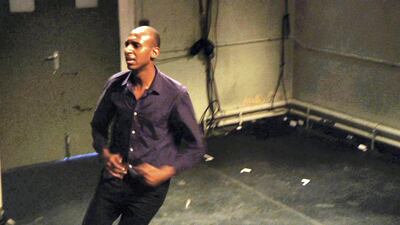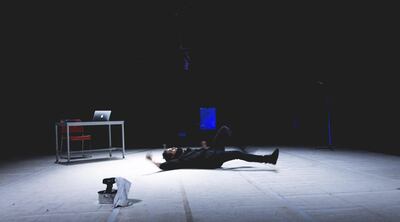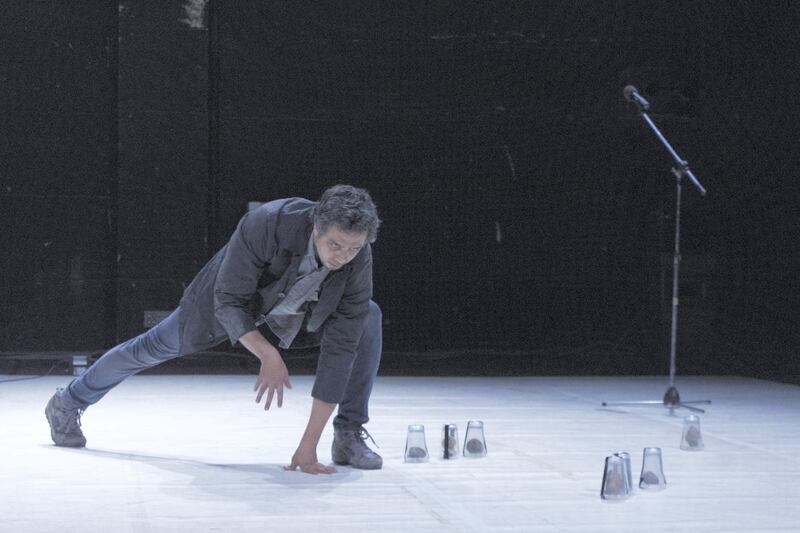When the prestigious Total Theatre Awards nominations were announced last week, recognising excellence at the Edinburgh Festival Fringe, one particular show stood out. The Arab Arts Focus: Dance Double Bill is in contention for the dance award, despite its previous precarious state when it looked destined to be cancelled a few days before the Fringe began.
"It's a nice cherry on top," says Shaymaa Shoukry, who put the show together. The award nomination is certainly a high point in what has been a harsh year for the Egyptian choreographer. A car accident in April put her own dancing career in jeopardy, then visa issues left her first Edinburgh Fringe show hanging by a thread.
The Dance Double Bill is part of the Arab Arts Focus, an ambitious multi-disciplinary event bringing numerous performers from the region to the world's biggest arts festival. The original line-up featured Shoukry's piece Mayhkomsh, to be performed by the Egyptian dancer Nagham Saleh, while the other part was to feature the Palestinian dancer/choreographer Yazan Iwidat performing his own piece Running Away.
However, visa issues that affected much of the Arab Arts Focus programme hit this show particularly hard: both Saleh and Iwidat were denied entry into the UK. Shoukry's visa was approved, but would the trip be worthwhile, with no dancers to work with? "I didn't know what was happening," she admits. "The night before I'm travelling at dawn tomorrow, and I didn't know if I was travelling or not."
The car accident happened in April, leaving Shoukry with two broken vertebrae and an uncertain future. "I had to cancel all my travels, works, workshops, and pay a lot of money because I don't have insurance – it's kind of heartbreaking, like a cosmic joke."
Unable to dance, she travelled to the UK with various ideas about how to salvage the production. There was talk of using local dancers, although that might have seemed odd within the Arab Arts Focus, and the possibility of rotating performers each day. Then Shoukry had an idea, and a stroke of luck. Her actor friend Mahmoud El Haddad was nearby – but not for long.

"He was in Europe, on his way back from France on a layover," she says. "Before he boarded the plane I sent him a text message, 'Would you like to come and do this?'. He said, 'I'll think about it.' I said, 'What about you miss your flight to Cairo, and come directly to Edinburgh?' And he lost his luggage on the way – he's been here two weeks without his luggage. But he's full of energy to work, very positive."
The piece they created requires lots of energy. With a few days to spare they combined two of Shoukry's previous compositions into a new piece entitled The Resilience of the Body. Wearing street clothes, El Haddad runs increasingly weary circles around the stage as if being pursued, while chanting evocative phrases ("I will keep running, until I let it all out"), until he gracefully spins to a stop. It's a remarkable performance, as we watch him tire and appear ready to collapse, but continually rally.
Shoukry suggests that El Haddad will run four kilometres during each of the 23 scheduled performances.
Even when the show was forced to stop, during one afternoon performance, he wouldn't give up.
"At one show, the fire alarm starts, the audience are leaving, and the dancer doesn't stop, he keeps on running. He kept running around me, so I had to catch him and tell him – he didn't want to stop the show. When the audience were ready to go back he said, 'You know what, I'm going to keep on running.'
"So as they came in, he was still running, it was so cool. Just when you think you've had enough of seeing the same thing every day, some kind of cosmic intervention will come along to freshen things up."
Shoukry announces the change to the programme in a speech before each show, as the second part of the double bill now features films of the originally planned performances. Most audiences have been appreciative, but not all.
"Putting on something absolutely new at such a big festival is very scary," Shoukry admits. "Sometimes people would walk out. Four Dutch people wanted their money back: they said, 'We came especially from Holland to see live dance and you're showing us videos!'"
The live performance does also raise an interesting question: what constitutes dance? "I wonder if people are frustrated by The Resilience of the Body," says Shoukry. "Yesterday, two people walked out in the last minute of his live performance. And one time, someone walked out after one minute of his performance."
Also pondering that question is another choreographer in the Arab Arts Focus strand, Youness Atbane. His production Second Copy: 2045 starts as what appears to be an intense, dramatic dance piece, as he moves around the space as if repossessing his own body – a theme that becomes clear at the end of the show – but in between the show becomes a humorous mock documentary from the future. Here the audience actually laugh at his movements, as he crawls around the stage with various items on his neck and back: a money-filled shoe, a laptop, which is showing ice dancing. So what does he call it, and himself?
"I studied dance and visual arts," he explains. "Most of the time the visual arts community consider me a choreographer, and choreographers consider me a visual artist – so it's a way to bring different communities together."
Does he mind audiences laughing at his work?
"Humour, I use it as a tool," he says. "It doesn't interest me that the audience feel these moments of the choreography, the intensity, I say no, these are our tools, let's abuse visual art and throw it in the stage, and make it as clear as possible for people."
"Sometimes I participate in the [Arab Arts Focus cabaret show] Chill Habibi in the night, and I always introduce it with the fact that, 'OK, I was supposed to show you a choreography, but it's me that got the visa, but I'm not sure if the choreography got a visa, so maybe if I show it, it'll be illegal?' – I play this game to push also the question about this big problem."
For those participants who did make it to Edinburgh, this Arab Arts Focus strand has provided a useful meeting place. Atbane and Shoukry have met to discuss their differing positions.
“She was more about the idea of physicality, and me, it was about escaping as much as possible from any arts practise,” says Atbane.

Labels aside, generally speaking this has been a notable year for Arabic dance at the Fringe. The Dance Double Bill is in line for another award, which should be announced soon. Meanwhile this past weekend the Arab Arts Focus also launched three 90 minute-dance showcases, staged at Edinburgh's impressive Dance Base, curated by the Algerian choreographer Nedjma Hadj Benchelabi.
These programmes were also hit by visa issues but thankfully went ahead successfully, featuring new pieces by the young contemporary choreographers/dancers Farah Salah, Salma Ataya, Yassin Mrabtifi and Samir Mrikech. "Our Dance Programme can be 'altered' but it will still shine," said Benchelabi.
And outside of that strand, one of the festival's milestone events this year is Requiem for Aleppo, a one-off gala performance of a project originally debuted at London's Sadlers Wells Theatre in April.
This high-profile production shares a thematic link with The Resilience of the Body; the 12 dancers run on the spot to represent their struggle against an unseen situation or pursuer, and also become evidently weary. They perform to a score mixing Requiem Mass lyrics and choral music with Arabic poetry and – most hauntingly - voices from the besieged Syrian city.
Shoukry's score for The Resilience of the Body is also unique and ominous: a series of grinding mechanical sounds that seem to be chasing El Haddad's runner around his stage. Where did she source it?
"When we were coming here, I had to have another MRI scan – this is actually the sound of the MRI," she says. "I felt like I didn't have music for this piece yet, but it's a very relevant sound."
For such talents, adversity may just be art waiting to happen.
__________________________
Read more:
Dubai Opera announces Chamber Music series
Edinburgh Fringe 2017 highs and lows
[ First look: Dubai's La Perle performers take to the stage ]
__________________________










